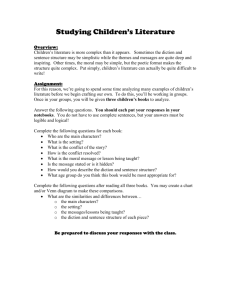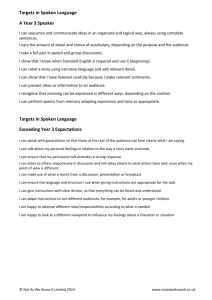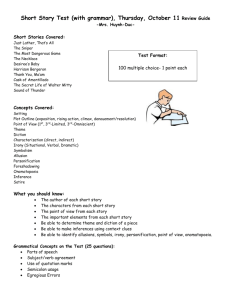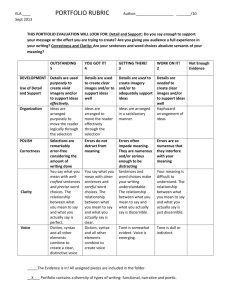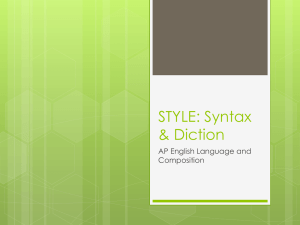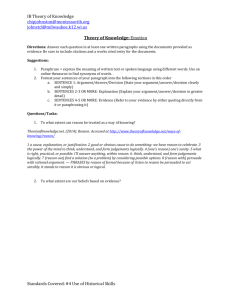Unit 1.5 Flash Card Terms - Liberty Union High School District
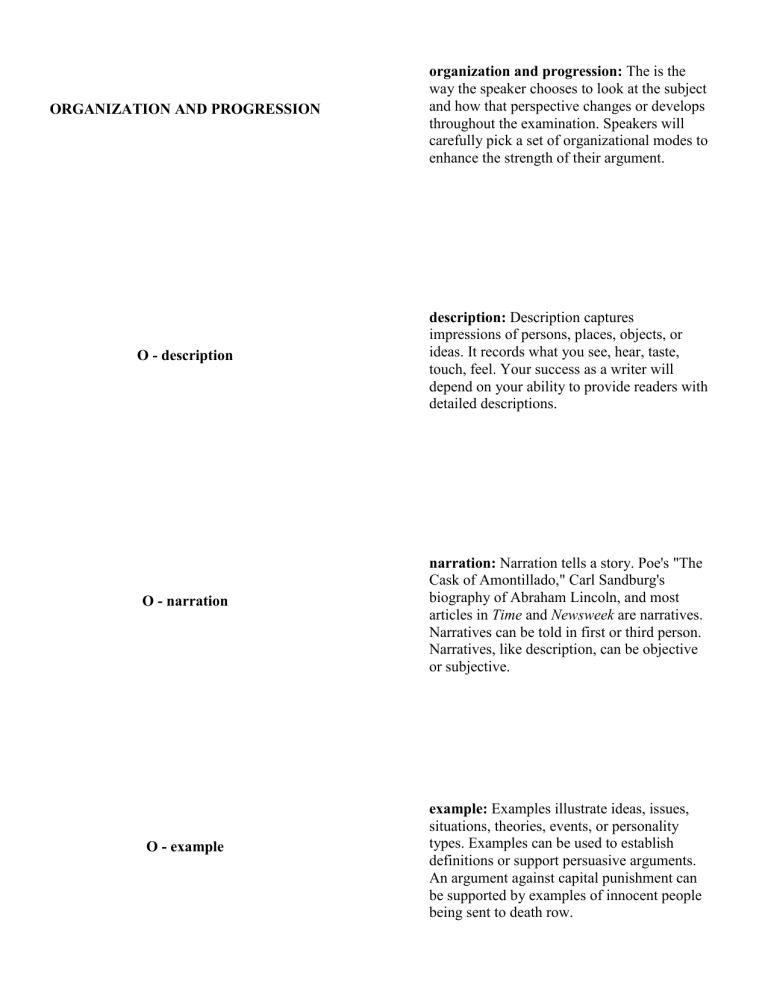
ORGANIZATION AND PROGRESSION organization and progression: The is the way the speaker chooses to look at the subject and how that perspective changes or develops throughout the examination. Speakers will carefully pick a set of organizational modes to enhance the strength of their argument.
O - description description: Description captures impressions of persons, places, objects, or ideas. It records what you see, hear, taste, touch, feel. Your success as a writer will depend on your ability to provide readers with detailed descriptions.
O - narration
O - example narration: Narration tells a story. Poe's "The
Cask of Amontillado," Carl Sandburg's biography of Abraham Lincoln, and most articles in Time and Newsweek are narratives.
Narratives can be told in first or third person.
Narratives, like description, can be objective or subjective. example: Examples illustrate ideas, issues, situations, theories, events, or personality types. Examples can be used to establish definitions or support persuasive arguments.
An argument against capital punishment can be supported by examples of innocent people being sent to death row.
O - definition
O - comparison/contrast
O - process definition: Definitions can be complex and controversial. Many legal battles are actually disputes over definition. Someone suing for slander or copyright infringement must prove that the other party' s actions matches the legal definitions. comparison/contrast: these essays measure similarities and differences between subjects.
Sportswriters compare teams. Textbooks compare related theories and methods.
Consumer Reports examines competing products. Essay exams often ask students to compare authors, historical events, political figures, or scientific techniques process: this shows how something functions or how to accomplish a task step-by-step. A biology book, for example, will discuss how the liver functions as a process. The operation of an anti-drug community effort can be explained as a process.
O - division and classification division and classification: Division separates items into categories. Complex subjects are easier understood when broken down into smaller groups. Classification rates or ranks the groups. Homicide, for instance, is classified as first, second, and third degree murder.
O - cause and effect cause and effect: Cause and effect writing seeks to determine reasons and predict results.
Establishing causes demands collecting sufficient evidence and exercising critical thinking.
O - analysis
DICTION
D - informal/formal diction analysis: analysis moves beyond describing a subject to evaluating its significance. A book review not only summarizes a new book but comments on its contents, style, and accuracy.
A stock broker analyzing a company not only reports on obvious facts, but determines if it would make a sound investment. diction: Diction is the writer’s word choice.
Writers choose the language they use in order to suggest their tone of voice and attitude toward the subject. They also use loaded language, words with positive or negative associations, to do this. The tone and attitude of a writer shapes audience mood.
informal/formal diction: Informal diction uses words encountered in informal settings, like a frat party. Formal diction uses words appropriate for formal settings, like a lecture hall. [Consider three verbs that mean roughly the same thing: bug , annoy , exacerbate .]
D - concrete/abstract diction concrete/abstract diction: Concrete diction uses words which refer to perceptible things
[a rose, a thunderclap, a doorman, etc.]
Abstract diction uses words which signify things that cannot be perceived [honor, generosity, sacrifice, democracy.]
D - denotative/connotative diction
D - plain/ornate diction
SYNTAX DEVICES denotative/connotative diction: Denotative diction uses words in a literal sense.
Connotative diction uses words “loaded” with non
‐ literal suggestion. [the denotative meaning of the word knife is a utensil used to cut; the connotative suggestion is fear, violence, etc.] plain/ornate diction: Plain diction avoids the use of vivid and descriptive words, as well as figurative language. Ornate diction is highly decorated. [She gave me flowers... versus… she offered me a loose cluster of daffodils, a shimmering fire clutched in her outstretched hand.] syntax devices: syntax is the way an author chooses to join words into phrases, clauses, and sentences. Syntactical structure is one way writers draw attention to their logic, diction, imagery, and figurative language.
S - segregated sentences
S - freight train sentences
S - triadic
S - parallelism segregated sentences : Segregated sentences are a series of simple sentences separated by the period. [He writes 750 words a day. He writes and rewrites. He polishes and repolishes. He works in solitude. He works with agony. He works with sweat.] freight train sentences : Freight
‐ train sentences are a series of simple independent clauses joined by conjunctive elements. [And the rain descended and the floods came, and the winds blew, and beat upon the house; and it fell: and great was the fall of it.] triadic : A freight train sentence composed in three units is triadic. The triadic sentence provides a clearer structural principle that is not open
‐ ended. [Her showmanship was superb; her timing sensational; her dramatic instinct uncanny.] parallelism: Parallelism means that two or more grammatical constructions stand in an identical relationship to the same thing.
Parallelism is pleasant to hear and economical. [We will come when we are ready and when we choose .]
S - balanced sentence
S - loose sentence
S - periodic sentence
S - convoluted sentence balanced sentence: Balanced sentences consist of two parts roughly equivalent in both length and significance and divided by a pause. Balanced elements may repeat the same idea or show a related idea. [Visit either you like; they’re both mad.] loose sentence : Loose sentences begin with the main clause followed by subordinate clauses and phrases. The phrases and clauses add detail to the main clause. [I found a large hall, obviously a former garage, dimly lit, and packed with cots.] periodic sentence : Periodic sentences begin with the subordinate clauses and phrases followed by the main clause. [Given a moist planet with methane, ammonia, and minerals, exposed to ultraviolet radiation at the right temperature, life might start almost anywhere.] convoluted sentence : Convoluted sentences split the main clause and place subordinate clauses and phrases in the middle. This establishes strong emphasis by throwing weight upon either end of the sentence. [Now demons, whatever else they may be, are full of interest.]
S - inverted sentence
S - sentence fragment
S - anaphora
S - epistrophe inverted sentence: Inverted sentences place the predicate before the subject. This inversion in normal sentence order may draw emphasis to an idea or may create a more pleasing rhythm. [In California grow oranges.] sentence fragment : Sentence fragments are single words, phrases, or dependent clauses standing alone as sentences. In formal writing, fragments may only be used to add unusual emphasis. [That nightmare was almost realized in Hitler’s totalitarian system.
Almost, but not quite .] anaphora : Anaphora repeats a word or words at the beginning of successive phrases, clauses, or sentences. [ This royal throne of kings, this sceptred isle, / This earth of majesty, this seat of Mars, / This other Eden, demi-paradise, / This fortress built by Nature for herself…] epistrophe : Epistrophe ends a series of successive phrases, clauses, or sentences with repetition of a word or words. [What lies behind us and what lies before us are tiny compared to what lies within us .]
S - anadiplosis
S - epanalepsis
S - chiasmus
S - asyndeton anadiplosis : Anadiplosis repeats the last word or phrase from the previous line, clause, or sentence at the beginning of the next. [The love of wicked men converts to fear / That fear to hate , and hate turns one or both / To worthy danger and deserved death...] epanalepsis : Epanalepsis repeats at the end of a line, phrase, or clause a word(s) that occurred at the beginning of the same line, phrase, or clause. [In times like these , it is helpful to remember that there have always been times like these .] chiasmus: Chiasmus repeats a phrase or clause but inverts the parallelism. Often the reversal adds depth to the meaning of the phrase. […ask not what your country can do for you—ask what you can do for your country.] asyndeton : Asyndeton connects sentence elements together without conjunctions. [The habits of the natives are disgusting; the women hawk on the Floor, the forks are dirty; the trees are poor; the Pont Neuf is not a patch on London Bridge; the cows are skinny…]
S - polysyndeton polysyndeton : Polysyndeton uses many conjunctions between sentence elements, often slowing the tempo or rhythm. [His hair and face and eyes and mouth combined to form an image of absolute power.]
S - zeugma
S - ellipses
S - parenthesis/epanorthosis zeugma : Zeugma lets one part of speech govern two or more other parts of a sentence.
Usually the controlling part of speech is the main verb, but sometimes it is a noun. [The teenage sweethearts, the elderly couple, and the flickering candles all danced late into the night.] ellipses : Ellipses omits a word or short phrase easily understood in the context of the surrounding sentences. The omission catches the audience’s attention and draws attention to the idea. [The average person thinks he isn't.] parenthesis/epanorthosis : Parenthesis interrupts a thought. [What I am trying to say, and I do not think this an unfair comment, is that we were a more idealistic generation.]
Epanorthosis interrupts and rewords for strength. [I am angry—no, I am furious about the delay.]
FIGURATIVE LANGUAGE
F - imagery
F - analogy
F - simile figurative language: the figurative meaning of a word or phrase goes beyond literal meaning. Figurative language seeks to accentuate meaning by tapping into the associative connections to words or phrases.
This is always intentionally done to reveal tone and attitude and shape mood. imagery: Imagery is the sensory description used to make an audience vividly picture the concrete details of a thing and emotionally feel the associative weight of those details as well. [My hand was sweating as I held the pistol. The curve of the trigger was biting my finger.] analogy: Analogies examine the similarities between two different things in order to explain the thing that is unfamiliar by relating it to the thing that is familiar. [Reading without a defined purpose is similar to grocery shopping without a list.] simile: Similes are brief comparisons between unlike things, usually introduced by the word like or as . [Probably you will find a girl like a grasshopper whom you think is a bell cricket.
And finally, to your clouded, wounded heart, even a true bell cricket will seem like a grasshopper.]
F - metaphor
F - personification
F - symbol
F - allegory metaphor: Metaphors are brief comparisons between unlike things, introduced directly. [I have measured out my life with coffee spoons…I should have been a pair of ragged claws / scuttling across the floors of silent seas.] personification: Personifications are comparisons that endow non-human things with human attributes or emotions. [As
London increased, however, rank and fashion rolled off to the west, and trade, creeping on at their heels, took possession of their deserted abodes.] symbol: Symbols are usually concrete things which represent something abstract. They are like metaphors but the abstract comparison is implied not introduced directly. [If the stars should appear one night in a thousand years, how would men believe and adore…] allegory: Allegories use a variety of story elements symbolically to represent abstract ideas. Allegories often deal with moral truths about humanity or life. [For example, a character might represent the poor and the candlelight in his shop window fading hope.]
F - allusion
F - apostrophe
F - metonymy
F - hyperbole allusion: Allusions refer to a commonly known person, place, event, poem, play, story, painting, sculpture, song, etc. Allusions can be historical, literary, religious, topical, or mythical. [The accident was of Titanic proportions.] apostrophe: Apostrophes directly address an absent person, who may be real, imagined, or abstract. The effect may add familiarity or emotional intensity. [Milton, thou shouldst be living at this hour: / England hath need of thee.] metonymy: Metonymy substitutes the name of one object for that of another closely associated with it. [There is no question that the White House has done everything in its power to cooperate fully with the crown…to no avail.] hyperbole: Hyperbole uses deliberate exaggeration or overstatement. Hyperboles may have either a comic or serious effect.
[Only the giant who was my father remained the same. / A hundred strong men strained beneath his coffin / When they bore him to his grave.]
F - understatement
F - irony
F - idiom
F - euphemism understatement: Understatement presents something as less significant than it is. The ironic effect can either be humorous or emphatic. [For example, Mercutio calls his mortal wound a “scratch” in Romeo and
Juliet .] irony: Irony contrasts appearance and reality.
[ Verbal irony states the opposite of what is meant. S ituational irony presents an event which resolves opposite to expectation.
Dramatic irony presents a character who is ignorant of key situational details of which the audience is aware.] idiom: Idioms are expressions that mean something other than the literal meaning of the individual words. [I recommend you hit the books tonight or you’ll be up a creek without a paddle come test day.] euphemism: Euphemisms are substitute expressions for unpleasant ones. A speaker may use a euphemism when they wish to soften a harsh idea. [We placed his corpse into his coffin… versus…We placed his earthly remains into his final resting place.]
F - pun
F - cliché
F - antithesis
F - paradox pun: Puns are words employed in two senses, or words used in a context that suggest terms that sounding similar. Puns are usually used for comic effect. [During the two previous centuries musical styles went in one era and out the other.] cliché: Clichés are trite expressions, devalued by overuse. A speaker may use a cliché to satirize a subject. [Absolute power corrupts absolutely, Back to square one, Call a spade a spade, Dead as a doornail, Eat like a horse, etc.] antithesis: Antitheses place dissimilar items close together for contrast. [Though studious, he was popular; though argumentative, he was modest; though inflexible, he was candid; and though metaphysical, yet orthodox.] paradox: Paradoxes are statement that appear to be self
‐ contradictory, but contain some degree of truth. Oxymorons are a type of paradox. [I can resist anything except temptation…It was the best of times, it was the worst of times… Spies do not look like spies…jumbo shrimp.]
F - alliteration
F - onomatopoeia
DEDUCTIVE ARGUMENT
A - premises alliteration: Alliteration is the repetition of initial consonant sounds in close proximity.
The repetition can be used to draw attention to a passage or to enhance imagery by recreating a related sound. [I must go down to the seas today, to the lonely sea and the sky…] onomatopoeia: Onomatopoetic words imitate natural sounds that match the word meaning.
This device can be used to draw attention to a passage or to enhance imagery by recreating a related sound. [buzz, hiss, hum, crack, whinny, murmur.] deductive argument: Deductive arguments are generally viewed as the most precise and the most persuasive; they provide conclusive proof of their conclusion, and are either valid or invalid.
Deductive arguments have three stages: premises, inference, conclusion. premises: A deductive argument always requires a number of core assumptions. These are called premises , and are the assumptions the argument is built on; or to look at it another way, the reasons for accepting the argument.
A - inference
A - conclusion
A - fallacies
A - ad hoc inference: In inference, you start with one or more premises which have been accepted; you then use those to infer, or propose, a new idea. If the idea is valid, you can use the new idea to propose another inference. conclusion: Hopefully you will arrive at an idea which is the conclusion of the argument, the idea you are trying to prove. A conclusion is the final step of inference. fallacies: There are a number of common pitfalls to avoid when constructing a deductive argument; they're known as fallacies . A fallacy is a technical flaw which makes an argument unsound or invalid. ad hoc: If we're trying to establish the truth of
B, then "A because B" is not an argument, it's an explanation. The Ad Hoc fallacy is to give an after-the-fact explanation which doesn't apply to other situations.
A - ad hominem
A - ad nauseum
A - non sequiter
A - red herring ad hominem: Argumentum ad hominem literally means "argument directed at the man" and it occurs when you justify your refusal to accept an idea by criticizing the person who made the statement. This is a fallacy because the truth of an idea doesn't depend on the virtues of its presenter.
ad nauseum: This is the belief that an idea is more likely to be accepted as true, the more often it is heard. So an Argumentum ad
Nauseam employs constant repetition in asserting something; saying the same thing over and over again until you're sick of hearing it. non sequiter: A non sequitur is an argument where the conclusion is drawn from premises which aren't logically connected with it. For example, “Since Egyptians did so much excavation to construct the pyramids, they were well versed in paleontology.” red herring: This fallacy is committed when someone introduces irrelevant material to the issue being discussed, so that everyone's attention is diverted away from the points made, towards a different conclusion.
A - slippery slope
A - straw man slippery slope: This argument states, without proof, that should one event occur, so will other harmful events. For example, “If we legalize marijuana, then more people would start to take crack and heroin, and we'd have to legalize those too. Before long we'd have a nation full of drug-addicts on welfare.” straw man: The straw man fallacy is when you misrepresent someone else's position so that it can be attacked more easily, knock down that misrepresented position, then conclude that the original position has been demolished.
